 I’ve been following the insanely popular—yet excruciatingly brutal—Game of Thrones for several seasons now. I must confess, partly because I don’t own or watch TV, that I am a little behind. I’m currently watching Season Four, while still metaphorically shaking in the violent wake of the shocking and brutal Red Wedding episode of Season Three. As the Internet buzz revealed, this was an extremely difficult show to watch for everyone. What was the purpose of its graphical brutality? Who needs to see that level of violence? I am reminded of an introductory scene in the show in which character John Snow counsels his little brother Bran to not avert his eyes when his father executes a deserter, by chopping off his head—an act that foreshadows his own decapitation later in the series. It is as though the producers of the show are counselling us in the same way as they subject us to grisly scene after grisly scene. Many cheap and gratuitous, as far as I am concerned.
I’ve been following the insanely popular—yet excruciatingly brutal—Game of Thrones for several seasons now. I must confess, partly because I don’t own or watch TV, that I am a little behind. I’m currently watching Season Four, while still metaphorically shaking in the violent wake of the shocking and brutal Red Wedding episode of Season Three. As the Internet buzz revealed, this was an extremely difficult show to watch for everyone. What was the purpose of its graphical brutality? Who needs to see that level of violence? I am reminded of an introductory scene in the show in which character John Snow counsels his little brother Bran to not avert his eyes when his father executes a deserter, by chopping off his head—an act that foreshadows his own decapitation later in the series. It is as though the producers of the show are counselling us in the same way as they subject us to grisly scene after grisly scene. Many cheap and gratuitous, as far as I am concerned.
The Red Wedding scene, in which several beloved characters are brutally slaughtered set into play a new set of rules for audience engagement: that of total distrust. Distrust in the storytellers (primarily in the producers of the show, whose scripts, I’m told, have deviated from the novels in some important ways). Distrust that creates an uneasy tension. Distrust that precipitates a panicked wish for clairvoyance. This is because we have no concept of fairness in the story; yet we’ve so invested in the characters. That is the storyteller’s worst act of cruelty: to hold us hostage to the characters. The rules of fair play in story have been broken. We’re stuck in a kind of free fall, desperately hoping that our beloved characters will make it through the night intact, if not unscathed. And when they don’t, its like watching our children die, as we stand powerless by.
Good fiction—as opposed to reality—tells a purposeful story. A story with fictional characters, who play a purposeful role. All good stories make a promise in the beginning; a promise they keep in the end. They create a covenant with their audience to participate in a fulfilling journey. This doesn’t have to mean a happy ending, but it does include meaning and fulfillment—even if only for its audience. And that must involve victory of sorts—and hope—whether it is through redemption, acceptance, enlightenment, or some change that gives us “more”—not less; something that allows us to prevail alongside.
If I feel that I am simply witnessing a cesspool of meaningless chaos and brutality, dominated by ruthless and insane people, in which heroes are equally powerless victims as they are true agents of change—with no rhyme or reason to tell the difference—then I must ask myself the question: why am I watching this? What does this story mean to me? I start to feel like a misanthropic voyeur, as perverse as Joffrey or Littlefinger as I watch people get tortured, flayed alive, dismembered, and worse… with no recourse. This is NOT entertainment and it certainly isn’t of any value to me. For such an offence to the senses to have value, there must be an element of—or at least a grain of hope of—prevailing and movement.
By Season Three end, both the series and I are feeling a little tired. And for good reason; most of the characters—the women particularly—are trapped in an incessant pattern of simple endurance. That seems to be all they are able to do: endure. Certainly they manage to act and create within their limited sphere of influence; but mostly to colour their position, not change it. So, we endure alongside; and we can endure only so much.
Then enter Brienne of Tarth. Also known as Maid of Truth.
And with her, a breath of much needed fresh air.
When Brienne was first introduced in “What is Dead May Never Die” in Season Two, she brought with her the anachronistic romanticism of a true knight. We first see her besting favored champion Ser Loras Tyrell (Knight of Flowers) in a tournament. When she presents herself to King Renly Baratheon and removes her helm, the crowd hushes in surprise. To his offer of prize, Brienne requests a place in his Kingsguard, which he gladly grants, despite her gender and lack of formal stature as a knight.
Brienne is the iconic knight of the chivalric sagas: noble, virtuous, compassionate and brave. Singularly honest and loyal. So much so that her contemporaries deride her as simple, naïve and stupid. As though embracing such virtues is outmoded, foolish and weak. That she is a woman—albeit tall, ungainly and considered unfeminine—makes her virtues all the more powerful and refreshing.
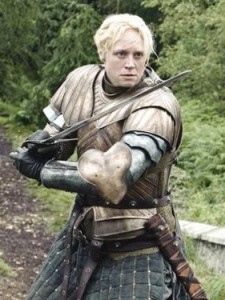 When King Renly is assassinated, Brienne swears fealty to Catelyn Stark and becomes her sworn sword. Catelyn charges Brienne to return her captive Jaime Lannister to King’s Landing to exchange him for her two daughters held hostage there. Their journey provides some of the best scenes of the TV series and some of the most fulfilling interactions. Throughout Jaime’s insufferable taunts about her appearance and likely dismal history with the opposite sex, Brienne remains stoically silent. Except when she speaks:
When King Renly is assassinated, Brienne swears fealty to Catelyn Stark and becomes her sworn sword. Catelyn charges Brienne to return her captive Jaime Lannister to King’s Landing to exchange him for her two daughters held hostage there. Their journey provides some of the best scenes of the TV series and some of the most fulfilling interactions. Throughout Jaime’s insufferable taunts about her appearance and likely dismal history with the opposite sex, Brienne remains stoically silent. Except when she speaks:
“All my life men like you’ve sneered at me, and all my life I’ve been knocking men like you into the dust.”—Brienne to Jaime Lannister, Game of Thrones
Essayist Brent Hartinger suggests that Brienne’s character is a well-written departure from fantasy novels where the main characters are commonly “the slender… average-heighted, the conventionally abled and traditionally gendered.”
Essayist Caroline Spector describes Brienne as a “study in heartbreaking contradictions. She embraces the romantic ideals of her culture, both emotionally and through her actions, but is continually betrayed by the real world simply because she cannot turn herself into the woman the Westerosi legends tell her she should be.”
By upholding her ideals of integrity, Brienne refuses to conform to the established cultural expectations. Her very nature—from physique to comportment to idealism—defies the notion in Westeros that women are to be taken or coerced, and meant to endure their lot; not be agents of their own change. Spector describes Brienne as a woman who has “taken for herself most of the attributes of male power.” She embodies “how women who dare to take male power for their own are judged and treated not only in Westeros but in all conventionally patriarchal societies.”
The journey of Brienne and Jaime is a fine tale of initial antagonism, discovery, surprising tenderness and ultimate friendship, based on honour and mutual respect. Throughout, Brienne defends and encourages a flagging Jaime and he, in turn, saves her on several occasions, culminating in his return to rescue her from a brutal death in the bearpit.
What makes “The Bear and the Maiden Fair”—or any other scene in which Brienne and Jaime appear—so pleasing? We witness in the interactions between them an evolution in character, great opportunities for learning and redemption, and finally the development of an iconic friendship based on respect and equality—something normally reserved for individuals of the same sex—that neither had previously enjoyed. Like two souls missing something, each is a gift to the other. And though delivered differently, it is the same for both: honour, self-respect and faith in humanity. And neither is the same for their interaction.
“The bathhouse had been thick with the steam rising off the water, and Jaime had come walking through that mist naked as his name day, looking half a corpse and half a god.”—George R.R. Martin, A Feast for Crows
Brienne is the catalyst hero. She gives us hope. She gives us hope to save the world. She does this through her influence on others. By shear strength of her genuine goodness, Brienne transforms, challenges, and supports. She is über-strong, yet vulnerable; which Jaime recognizes and appreciates as something truly beautiful. The reason he returns to save her in the bear pit.
“I am grateful, but… you were well away. Why come back?”
A dozen quips came to mind, each crueler than the one before, but Jaime only shrugged. “I dreamed of you,” he said.—George R.R. Martin, A Storm of Swords
Jaime slides back to his scoundrel-self once returned safely to King’s Landing and out of Brienne’s sphere of influence—and beneath the shadow of his overbearing father. He is a chameleon, a shape shifter, who struggles to lift himself out from the shadow of his soulless father. Despite some continued reprehensible behavior (particularly to do with his sister, with whom he had formed a perverse relationship), Brienne’s light of honour appears to burn inside him in some form. His actions—tasking her to find and secure Sansa’s safety and giving her his own sword—maintains their honour-bond. When he gives her his longsword, forged of Valyrian steel, he asks her to name it; showing the cooperative respect between the two. She chooses the name Oathkeeper, fulfilling again her role in their story.
In fact, Brienne’s story follows a more traditionally male narrative. Her quest is to save the beautiful maiden (Sansa), but not to marry her or benefit from the quest; it is simply to secure her safety. Feminist writer Rihannon tells us that this is a storyline that “the mother, the young girl and the shieldmaiden are all given equal weight and worth…She uses her strength and her skill to respect and help other women in ways that most men in Westeros would never even think to attempt, because she understands, more than any other knight, that women are truly worth something as individuals.”
Are other women of Westeros poised to rise as true agents of change and take command not only of their lives but to save the world? Daenerys Targaryen, the dragon mother, liberates slaves; courage and a sense of justice animates the independent Arya. And we’ll see what becomes of Brienne…and Jaime.
command not only of their lives but to save the world? Daenerys Targaryen, the dragon mother, liberates slaves; courage and a sense of justice animates the independent Arya. And we’ll see what becomes of Brienne…and Jaime.
I will continue to watch this series with uneasy anticipation.
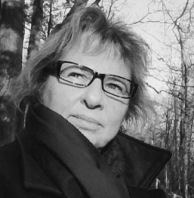 Nina Munteanu is an ecologist and internationally published author of award-nominated speculative novels, short stories and non-fiction. She is co-editor of Europa SF and currently teaches writing courses at George Brown College and the University of Toronto. Visit www.ninamunteanu.ca for the latest on her books.
Nina Munteanu is an ecologist and internationally published author of award-nominated speculative novels, short stories and non-fiction. She is co-editor of Europa SF and currently teaches writing courses at George Brown College and the University of Toronto. Visit www.ninamunteanu.ca for the latest on her books.
Nina’s latest release is La natura dell.acqua / The Way of Water, a bilingual story and essay on water and climate change (Mincione Edizioni, Rome), set in Canada.

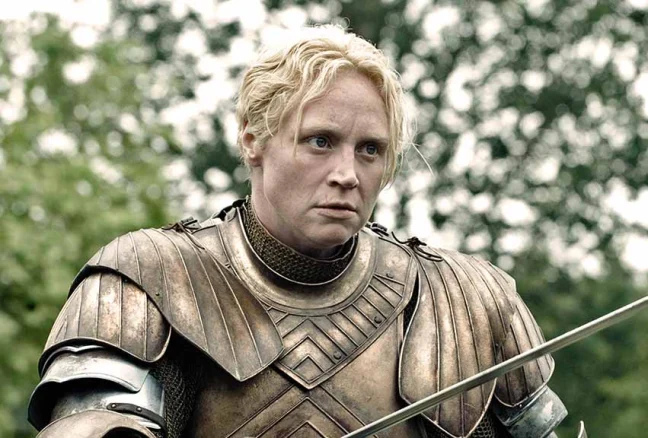

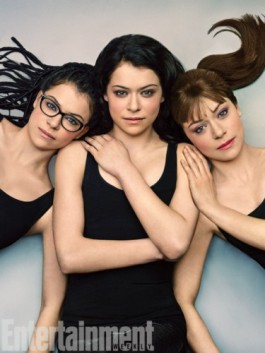 Canadian science fiction thriller Orphan Black, written by Graeme Manson and directed by John Fawcett—now in Season Two—stars the extraordinary multi-talented Tatiana Maslany in multiple roles of herself—really.
Canadian science fiction thriller Orphan Black, written by Graeme Manson and directed by John Fawcett—now in Season Two—stars the extraordinary multi-talented Tatiana Maslany in multiple roles of herself—really.
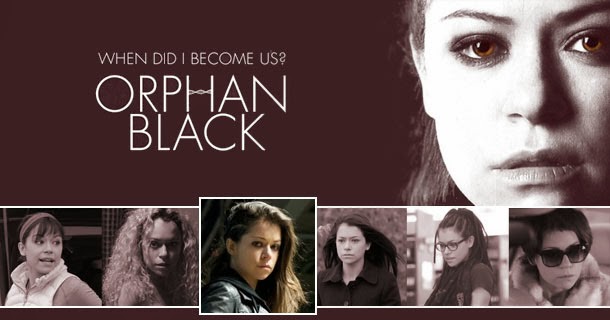
 Issues, brought on by GMO foods and medical genetic research, have propelled a major debate in gene patenting. The United States Supreme Court recently ruled against patenting sequences of the human genome in Association for Molecular Pathology Et Al. vs. Myriad Genetics, Inc., Et Al., reports Isabella Kapur in her article:
Issues, brought on by GMO foods and medical genetic research, have propelled a major debate in gene patenting. The United States Supreme Court recently ruled against patenting sequences of the human genome in Association for Molecular Pathology Et Al. vs. Myriad Genetics, Inc., Et Al., reports Isabella Kapur in her article: 

 The Dyad Institute, a biotech corporation with arcane connections to invisible powers and eugenics, patented the clones as theirs to do with as they please—which might be anything. The Neolutionists, a transhumanist movement pursuing “self-directed evolution” evokes social Darwinism and the Übermensch. All bring to mind the early American eugenics programs that inspired the fascist sonderweg and Hitler’s aggressive application of eugenics in the Holocaust. All are frightening.
The Dyad Institute, a biotech corporation with arcane connections to invisible powers and eugenics, patented the clones as theirs to do with as they please—which might be anything. The Neolutionists, a transhumanist movement pursuing “self-directed evolution” evokes social Darwinism and the Übermensch. All bring to mind the early American eugenics programs that inspired the fascist sonderweg and Hitler’s aggressive application of eugenics in the Holocaust. All are frightening.
 Where do we draw the line in our tightrope walk across the sea of chaos to find the Holy Grail? When does a Transhumanist’s individual expression of “transcendence” become a movement toward the Singularity? When does a singular powerful thought encompass an entire society?
Where do we draw the line in our tightrope walk across the sea of chaos to find the Holy Grail? When does a Transhumanist’s individual expression of “transcendence” become a movement toward the Singularity? When does a singular powerful thought encompass an entire society?


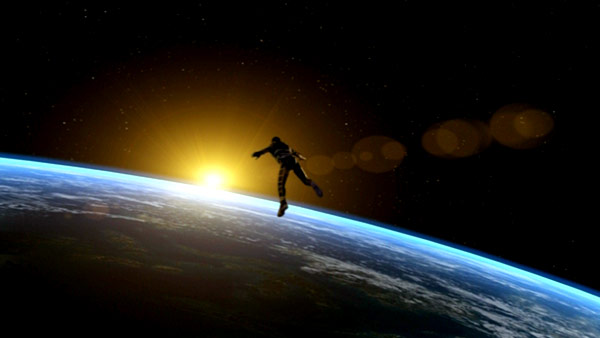
 Okay, I’m a late bloomer, or so I’ve been told by many of my relatives. And they’re probably right: I got married later than most and had my son even later. I didn’t join the 21st Century tecky scene with Internet service, websites, and cell phones until recently (yeah, really!). We still don’t have cable or satellite TV (and don’t plan on it soon either). And I still don’t have a cell phone, much to the chagrin of my teenage son. So, it’s no surprise that I discovered “Farscape” for the first time through an enthusiastic fan demo to re-instate the already cancelled show after four seasons!
Okay, I’m a late bloomer, or so I’ve been told by many of my relatives. And they’re probably right: I got married later than most and had my son even later. I didn’t join the 21st Century tecky scene with Internet service, websites, and cell phones until recently (yeah, really!). We still don’t have cable or satellite TV (and don’t plan on it soon either). And I still don’t have a cell phone, much to the chagrin of my teenage son. So, it’s no surprise that I discovered “Farscape” for the first time through an enthusiastic fan demo to re-instate the already cancelled show after four seasons!



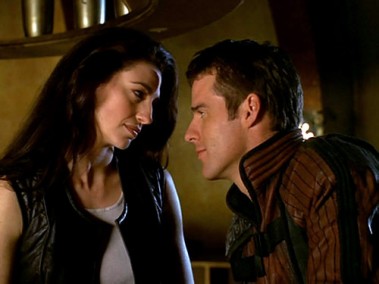



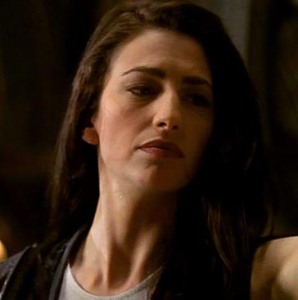


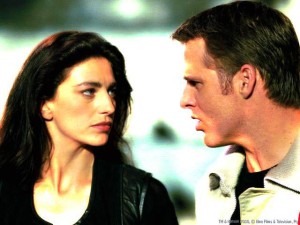
 From the very first scenes between these two very different people (in PK Tech Girl, John mutters: “I’m not like you,” and Aeryn hisses back: “Not even remotely.”) they have struggled with conflict and attraction. In PK Tech Girl, Aeryn blurts out, “In the beginning I found you interesting,” then quickly qualifies to Crichton’s puzzled half-pleased look, “But only for a moment.” The evolving relationship of John and Aeryn toward their first kiss was wonderfully constructed over several episodes. And when it happened (in The Flax) it combined pathos, explosive passion and humor in a complex and vivid scene that left me panting for more. Whether it is in conflict or in love and passion, or simply working cooperatively to solve a problem, Aeryn and John sizzle on screen, lighting each other on fire. Pivotal episodes of their growing (and struggling) relationship in the first season include: the Premiere; PK Tech Girl; DNA Mad Scientist; The Flax; A Human Reaction.
From the very first scenes between these two very different people (in PK Tech Girl, John mutters: “I’m not like you,” and Aeryn hisses back: “Not even remotely.”) they have struggled with conflict and attraction. In PK Tech Girl, Aeryn blurts out, “In the beginning I found you interesting,” then quickly qualifies to Crichton’s puzzled half-pleased look, “But only for a moment.” The evolving relationship of John and Aeryn toward their first kiss was wonderfully constructed over several episodes. And when it happened (in The Flax) it combined pathos, explosive passion and humor in a complex and vivid scene that left me panting for more. Whether it is in conflict or in love and passion, or simply working cooperatively to solve a problem, Aeryn and John sizzle on screen, lighting each other on fire. Pivotal episodes of their growing (and struggling) relationship in the first season include: the Premiere; PK Tech Girl; DNA Mad Scientist; The Flax; A Human Reaction.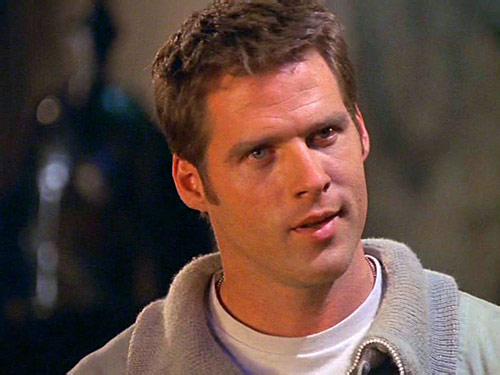
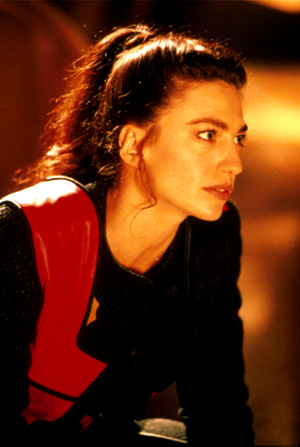
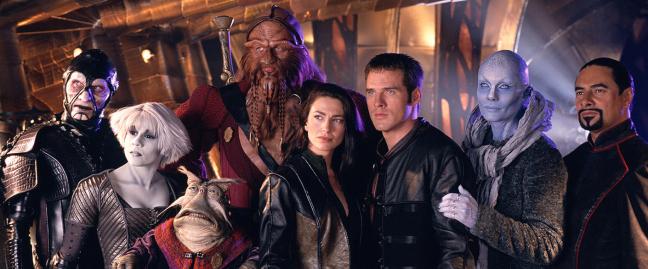 D’Argo (Anthony Simcoe), Zhaan (Virginia Hey), Rygel (Jim Henson Creature; voice by Jonathan Hardy), Pilot (Jim Henson Creature; voice by Lani John Tupu), Crais (Lani Tupu) and even Moya (the ship) provide a rich tapestry of imaginative setting whose filigree of characters provide humor (mostly Rygel), spirituality, conflict and drama to a show willing to take risks. D’Argo is the fierce Luxan warrior whose reaction to conflict is to attack first and ask questions never. Zhaan is a Delvian priest, whose dignified gentle demeanor provide a much needed level of balance and spiritual strength to the disparate group. In contrast, Rygel is a Hynerian, formerly royal sovereign of more than 600 billion subjects. His excessive concern with his own self-interest is barely eleviated by his small size and although he appears rather cute, this alien is far from sweet. He often serves the role of comic relief in the show. Lastly, there is the mild-mannered Pilot, who is symbiotically linked to the leviathan. Later in the season, other strange characters join Moya’s rag-tag group, adding spice, grit and confusion to the already careering homeless group (e.g., the wild bratty Nebari, Chiana, played by Gigi Edgley; and the Banik healer, Stark played by Paul Goddard).
D’Argo (Anthony Simcoe), Zhaan (Virginia Hey), Rygel (Jim Henson Creature; voice by Jonathan Hardy), Pilot (Jim Henson Creature; voice by Lani John Tupu), Crais (Lani Tupu) and even Moya (the ship) provide a rich tapestry of imaginative setting whose filigree of characters provide humor (mostly Rygel), spirituality, conflict and drama to a show willing to take risks. D’Argo is the fierce Luxan warrior whose reaction to conflict is to attack first and ask questions never. Zhaan is a Delvian priest, whose dignified gentle demeanor provide a much needed level of balance and spiritual strength to the disparate group. In contrast, Rygel is a Hynerian, formerly royal sovereign of more than 600 billion subjects. His excessive concern with his own self-interest is barely eleviated by his small size and although he appears rather cute, this alien is far from sweet. He often serves the role of comic relief in the show. Lastly, there is the mild-mannered Pilot, who is symbiotically linked to the leviathan. Later in the season, other strange characters join Moya’s rag-tag group, adding spice, grit and confusion to the already careering homeless group (e.g., the wild bratty Nebari, Chiana, played by Gigi Edgley; and the Banik healer, Stark played by Paul Goddard).